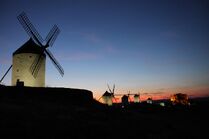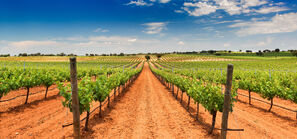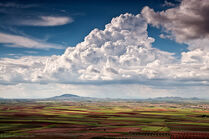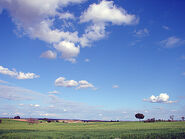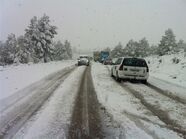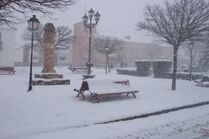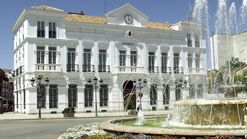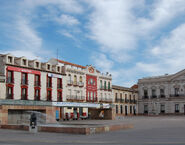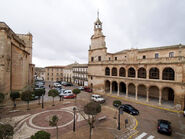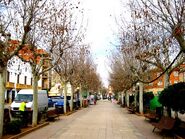| ||||||
| Capital | Albacete | |||||
| Largest City | Albacete | |||||
| Other Cities | Ciudad Real, Tomelloso, Puertollano, Valdepeñas, Hellín, Alcázar de San Juan | |||||
| Language | Castilian | |||||
| Religion | Roman Catholicism, Secularism | |||||
| Ethnic Group | Spanish | |||||
| Demonym | Manchegan | |||||
| Legislature | State Legislature | |||||
| Governor | Emiliano García-Page (PLE) | |||||
| Population | 1,774,011 | |||||
| Admission | December 1899 | |||||
| Currency | Peseta | |||||
| Time Zone | CET (UTC+1) | |||||
| Summer | CEST (UTC+2) | |||||
| Abbreviations | MAN | |||||
La Mancha is a state located in the Southeastern Region of Spain that shares borders with Murcia and Valencia to the east, Andalusia to the south, Extremadura to the west and Castilla to the North. La Mancha is a largely plain state, with much of its populace of just under 1 and a half million living in major cities like the state capital and largest city of Albacete (pop. 255,712), Ciudad Real, Tomelloso, or Puertollano.
La Mancha was formerly grouped with the province of Madrid into New Castile (Castilla la Nueva), but with the advent of the modern Spanish system of states (Estados), it was separated due to great demographic disparity between the capital and the remaining New-Castilian provinces. Also, distinct from the former New Castile, La Mancha added the province of Albacete, which had been part of Murcia; adding Albacete placed all of the historic region of La Mancha within this single region.
It is mostly in this region where the story of the famous Spanish novel Don Quixote by Miguel de Cervantes is situated, due to which La Mancha is internationally well-known. Although La Mancha is a windswept, battered plateau, it remains a symbol of Spanish culture with its vineyards, sunflowers, mushrooms, olive plantations, windmills, Manchego cheese, and Don Quixote.
History[]
The history of La Mancha has been significant. Its origin lay in the Muslim period between the 8th and 14th century. La Mancha was the region of many historical battles between Christian crusaders and Muslim forces during the period from 1000 to the 13th century. It was also the region where the Crown of Castile and Aragon were unified in 1492 under Queen Isabel and King Ferdinand.
La Mancha is the successor to New Castile (Castilla la Nueva), which in turn traces back to the Taifa of Toledo, one of the taifas of Al Andalus. Alfonso VI conquered the region from the Muslims, taking Toledo in 1085. The Reconquista ("Reconquest") took Cuenca in 1177. Other provinces to the south—the Campo de Calatrava, the Valle de Alcudia, and the Alfoz de Alcaraz (Campo de Montiel and Sierra de Alcaraz)—were consolidated during the reign of Alfonso VIII (reigned 1158–1214), whose conquests were completed by the Battle of Las Navas de Tolosa (1212). That victory assured Castilian domination of the region and hastened the decline of the Almohad Dynasty. From the time of the Reconquista, La Mancha formed part of the Kingdom of Castile. Four centuries later, in 1605, Cervantes' Don Quixote gave the world an indelible picture of La Mancha.
In 1785, the territorial organization by the reformer Floridablanca divided the region into the provinces of Cuenca, Guadalajara, Madrid, La Mancha, and Toledo. Albacete, Chinchilla, Almansa, Hellín and Yeste, however, became part of Murcia. In 1833 Javier de Burgos modified the provincial borders; most of the province of La Mancha was transferred to the province of Ciudad Real, with smaller parts incorporated into the provinces of Cuenca, Toledo and the newly created province of Albacete. Albacete, in turn, also incorporated parts of the territories of the old provinces of Cuenca and Murcia. Albacete was administered as part of the Region of Murcia until the 1978 configuration of autonomous regions. Nonetheless, during the First Spanish Republic, Albacete was one of the signatories to the Pacto Federal Castellano (1869) and in 1924 its deputation favored the formation of a "Comunidad Manchega" that would have recognized La Mancha (including Albacete) as a region.
Geography[]

Typical manchegan plains.
The largest plain in Spain, La Mancha is made up of a plateauaveraging 500 to 600 metres in altitude (although it reaches 900 metres in Campo de Montiel and other parts), centering on the province of Ciudad Real. The region is watered by the Guadiana, Jabalón, Záncara, Cigüela, and Júcar rivers. The climate is cold semi-arid (Köppen BSk), with strong fluctuations. Farming (wheat, barley, oats, sugar beets, wine grapes, olives) and cattle raising are the primary economic activities, but they are severely restricted by the harsh environmental conditions.
Culture[]

The Spanish imperial eagle can be found mostly in the region of La Mancha.
Culturally, La Mancha includes the Sierra de Alcaraz, northern Sierra Morena, Montes de Toledo and Serranía de Cuenca, parts of Tajo river valley, and it is administrative divided among the comarcas of Campo de Montiel and Campo de Calatrava to the south—Don Quixote himself starts his adventures in Campo de Montiel—the eastern Mancha Alta, the central Mancha Baja, the western Valle de Alcudia, and Parameras de Ocaña y Manchuela to the north.
The inhabitants are called Manchegos.
Agriculture[]
La Mancha has always been an important agricultural zone. Viticulture is important in TomellosSocuéllamos, Valdepeñas and Manzanares, in Ciudad Real and Villarrobledo in Albacete. Other crops include cereals (hence the famous windmills) and saffron. Sheep are raised and bred, providing the famous Manchego cheese, as are goats, including the La Mancha goat, one of the assumed progenitors of the American La Mancha goat. La Mancha includes two National Parks, Las Tablas de Daimiel and Cabañeros, and one Natural Park, Las Lagunas de Ruidera.

Manchegan landscape.
People[]
Famous Spaniards like the cinema directors Pedro Almodóvar and José Luis Cuerda, painters Antonio López and his uncle Antonio López Torres, footballer Andrés Iniesta, music band Angelus Apatrida and actress Sara Montiel were born in La Mancha.

A typical manchegan street.
La Mancha and Cervantes[]
Miguel de Cervantes described La Mancha and its windmills in his novel Don Quixote de La Mancha. Cervantes was making fun of the region, using a pun; a "mancha" was also a stain, as on one's honor, and thus an inappropriately-named homeland for a dignified knight-errant.[3] Translator John Ormsby believed that Cervantes chose it because it was the most ordinary, prosaic, anti-romantic, and therefore unlikely place from which a chivalrous, romantic hero could originate, making Quixote seem even more absurd.

The Manchegan windmills.
Several film versions of Don Quixote have actually been filmed largely in La Mancha. However, some, including the 1957 Russian film version, and the screen version of Man of La Mancha, were not. The 1957 film was shot in Crimea, while Man of La Mancha was filmed in Italy. G.W. Pabst's 1933 version of Cervantes's novel was shot in Alpes-de-Haute-Provence. The 2000 made-for-TV Don Quixote, starring John Lithgow as Don Quixote and Bob Hoskins as Sancho Panza, was shot on several locations in Spain, but not in La Mancha.
Counties[]
La Mancha is subdivided into 17 counties, which are listed below in order of population.

A map of counties in La Mancha. Notice the province separation.
| Rank | Name | Population |
|---|---|---|
| 1 | Mancha County | 346,294 |
| 2 | Calatrava County | 285,421 |
| 3 | Albacete County | 255,712 |
| 4 | Mancha Alta de Toledo County | 149,700 |
| 5 | La Mancha de Cuenca County | 125,221 |
| 6 | Mancha Júcar-Centro County | 86,223 |
| 7 | Monte Ibérico-Corredor de Almansa County | 77,436 |
| 8 | Campos de Hellín County | 67,320 |
| 9 | Manchuela County | 58,668 |
| 10 | Mesa de Ocaña County | 55,744 |
| 11 | La Manchuela County | 45,528 |
| 12 | Montes County | 44,091 |
| 13 | Montiel County | 41,854 |
| 14 | Sierra de Alcaraz y Campo de Montiel County | 41,074 |
| 15 | Alcudia County | 36,352 |
| 16 | Sierra Morena County | 28,690 |
| 17 | Sierra de Segura County | 28,683 |
Gallery[]
Photos of La Mancha's cities, towns and landscape. Please zoom for detail.












